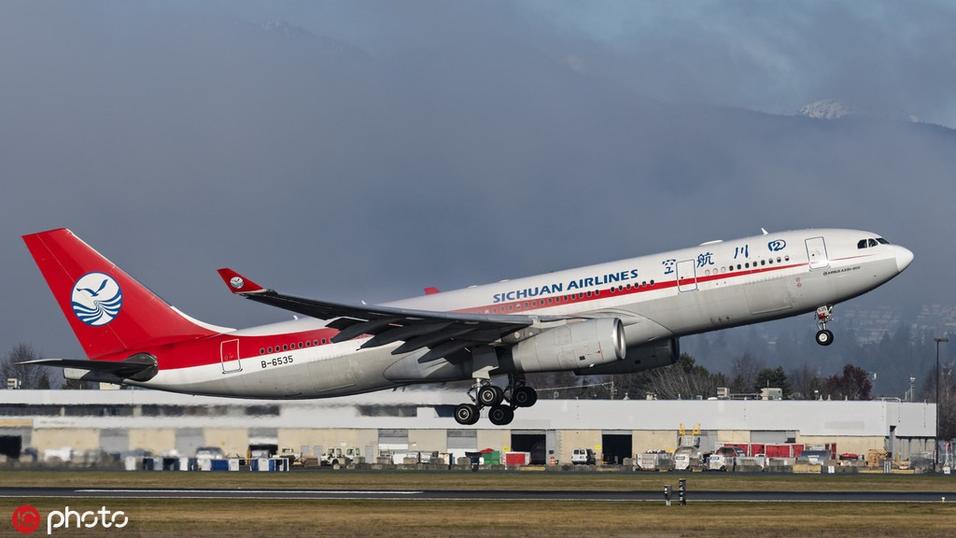 A Sichuan Airlines Airbus A330 wide-body jet airliner takes off. (PHOTO / IC)
A Sichuan Airlines Airbus A330 wide-body jet airliner takes off. (PHOTO / IC)
China's civil aviation sector has made great strides in the past five years, and further improvements are expected in the next five, experts said.
Li Xiaojin, a professor from the College of Economics and Management at the Civil Aviation University of China in Tianjin, said the sector's accomplishments in safety, scale and production volume "match China's status as the world's second-largest economy".
Significant growth in flight hours, infrastructure investment and the extent of China's air network has been witnessed during the period, along with improvements in transport quality
Yu Zhanfu, partner and vice-president for China at consultancy Roland Berger, said the progress seen during the 13th Five-Year Plan period (2016-20) includes "more flying hours, a larger aviation network and more investment in infrastructure".
READ MORE: China's civil aviation industry expands recovery
Significant growth in flight hours, infrastructure investment and the extent of China's air network has been witnessed during the period, along with improvements in transport quality, according to data released by the Civil Aviation Administration of China last week.
By September, China's passenger and freight airplanes had flown safely for 10 years and one month, or a total of 86.69 million flight hours. By June, passenger and freight flight hours since the start of the 13th Five-Year Plan were up 55.6 percent compared with the previous five-year plan period.
Forty-three airports will have been built or relocated once the latest five-year plan concludes by the end of this year, including Beijing Daxing International Airport and Tianfu International Airport in Chengdu, Sichuan province. That will give China 241 transport airports that handle passengers and freight and 313 general aviation airports that handle other types of flights.
ALSO READ: China eases curbs on domestic airlines to boost aviation market
China remained the world's second-largest civil aviation market last year, with 660 million passenger trips, up 7.9 percent year-on-year, the CAAC said.
The country had 5,521 fixed air routes last year, including 4,568 domestic routes and 953 international routes, connecting 234 Chinese cities. Chinese mainland carriers connected 66 Chinese cities with 167 cities in 65 countries.
There were 238 passenger and freight transport airports in China at the end of last year. In the five years to the end of this year, the country is expected to see 41 newly constructed runways along with 2,264 new stands for aircraft at airports and the 43 newly built or relocated airports.
"China's civil aviation industry has made a great contribution to the country's economic growth," said Zhang Qihuai, a senior lawyer who specializes in civil aviation, adding that more development can be expected in terms of safety, infrastructure, public transport and general aviation.
Li said the annual per capita rate of air travel for Chinese people was 0.5, which meant about 700 million air trips a year.
The annual per capita air travel rate globally is 0.6, while it is three in the United States.
"Although the development of high-speed railways will affect the number, it indicates that China's civil aviation sector still has room for development," he said,
Li estimated the annual per capita rate of air travel in China will reach 0.8, and possibly as high as one.
He said air travel is a fast way to travel and it is becoming cheaper, giving it a high performance-to-price ratio.
"Building two airports to connect two places is cheaper than building a high-speed railway," he said.
Li said large-scale investment in the building of civil aviation infrastructure will continue in the next five years because of demand in developed coastal areas. Local governments are willing to subsidize the building of new airports-in places such as Nantong, Jiangsu province, and Dalian, Liaoning province-and the expansion of existing ones.
Less-developed areas such as western and northeastern China and medium-sized and small cities that are trying to attract industries relocating from developed areas also need airports, Li added.
He said the COVID-19 pandemic had sharply curtailed the international market, which previously accounted for about 20 percent of China's civil aviation market.
But he said the domestic market has recovered gradually and is expected to match last year's level by the end of this year.
"During the National Day holiday this month, the recovery (of the domestic market) was nearly 100 percent," he said. "Some airlines that focused on the domestic market, such as Spring Airlines, saw passenger traffic surpass last year's figure."
However, Li said prices were still about 30 percent lower than before the pandemic.
"The price recovery will be a slow process," he said.
Zhang said he hopes laws and regulations related to civil aviation can be updated, especially adding more specific clauses related to people's day-to-day interests, such as the specific circumstances in which carriers can refuse to accept passengers.
Presently, carriers set their own individual standards, so he said he expects universal, more detailed and practical regulations to be rolled out to provide guidance to the whole industry.
Yu said that compared with passenger and freight flights, the speed of development was slower in general aviation. He said general aviation development was restricted by military airspace control, and if that was eased, a significant boom could be expected in the sector, which would contribute to economic growth.
"As China needs more economic growth stimulus, the development of general aviation is worth pursuing," he added.


